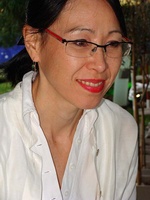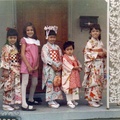“Are there any continuities,” wonders scholar Min Hyoung Song, “between the earlier generation of writers which first raised the banner of an Asian American literature and a later generation of writers which inherited it?” The Asian American Literary Review asked writers to respond to this question for their Spring 2012 issue on “Generations.”
Forum Response by Anna Kazumi Stahl
Given that I was born to a mixed race couple (Japanese and German) in the Deep South in 1963, I grew up in a context of rock-throwing, name-calling racism, explicit and publicly allowed. Of course, these attitudes were even then abhorred and being powerfully combated; soon enough they would be outlawed. But at the time, the narrow universe of the three blocks between my house and the schoolyard was a battle zone. Neither law nor social decency were on my side then. Indeed, as I came to know while researching Louisiana law for aspects of my first novel, Flores de un solo día (Flowers of a Single Day), the statutes were against our very existence as a family: my parents’ marriage had taken place in Japan and had been registered by the U.S. Consul General there as binding in the USA.
However, the fact of 1963 was that such a marriage between persons of different races was not recognized as legal in the State of Louisiana (the “sportsman’s paradise” as the license plates read). It was illegal until the Civil Rights legislation passed into federal law as binding in all states—in 1968. This meant that, had my Japanese mother been divorced or widowed before then, she would not have been entitled to custody of her children or to any monetary support (inheritance or alimony), and what was more, she would have been deported as an illegal, trespassing alien.
It wasn’t until I went to university in 1980—which also meant a move from the Deep South to New England—that I became apprised of efforts that supplied concrete, even jurisprudential responses to the racism I’d experienced growing up. Indeed, I began an accelerated phase of familiarization with “Affirmative Action thinking”: I had taken out loans to make my tuition payments, but later found out there were special scholarships available to “non-white minority” students. Senator Daniel Inouye had introduced a proposal the year before I entered college that led directly to the establishment of the Commission on Wartime Relocation and Internment of Civilians, which was to radically alter my generation’s knowledge of our own personal, family histories. We had no idea many members of our community had been forcibly relocated and interned.
In 1983, the year I went on my Junior Year Abroad to Europe (no such programs were readily made available to us for sojourns in non-European countries), that congressional Commission determined that the WWII internment of Japanese Americans had been unjust, and in 1988 (the year I got that fluke of a grant to interview ten “deterritorialized” intellectuals in Buenos Aires, Argentina, a fluke that was to open the floodgates to the felicitous though unforeseeable, unlikely course my future was to take) the United States President formalized the apology and made reparations to the Japanese Americans who’d been interned. “As if human matters could be resolved with just money”—so complained many older Japanese Americans we knew—the reparations came in the form of $20,000 checks.
So even as my life followed a course along the lines of white Occidental custom, assimilating me (the “other” parts of me), the “sidestepped” elements of truth in a collective history I shared were gradually coming to light.
This I presume is the work of the generation that Professor Min Hyoung Song cites above. In this autobiographical text, I only bear witness to how key that initial politicized generation’s bid was for all of us who would become adults—and some of us, artists and writers—as they used blunt, direct rhetoric to “raise the banner of Asian American identity” and, to be specific, imparted knowledge that had been concealed and that was essential if we were to understand fully who we were and in what contexts our sense of ourselves had been determined.
It is a mightily strange (and estranging) sensation to discover a historical chapter of such magnitude that has left a formal physical impact on one’s life and yet have never heard tell of it at all. My friends and I—entering college in 1980 and 1981 from the tiny Japanese American community in New Orleans (only about 100 families)—lurched painfully into the hard fact that most of us would never have been in New Orleans at all had it not been for the forced internment of Japanese Americans and later government “recommendation” that the newly released not re-concentrate on the West Coast. It was for that reason and no other that the families we grew up among had ended up taking root in southern Louisiana—it was by accident, by catastrophe; it was not unlike the happenstance destinies that suffer species of pollen or bees. Our parents, our friends’ parents, those aunts and uncles of affection, the ojisans and obachans we all shared, they had had lives as feckless and hijacked as microbes relocated in a breeze, or like birds thrown off their natural course by a volcano’s ash or salmon blocked and made barren at the blunt intervention of a concrete dam.
My best friends’ parents had been interned. And we’d never even sensed such a past.
In Joy Kogawa’s novel Obasan, the older generation veils what they have experienced to protect the children, to allow them to enter the world without such a sense of anti-privilege; they decide not to impart the information so that their sons and daughters and nieces and nephews will not have one more hang-up weakening them as they seek to grow and evolve into working, loving, creating adults.
Hence, much of the work we did depended on outside information sources. Feeling numb before distressed or enraged, we took in what the national news had to say about our elders’ formative years; in stunned silence we absorbed the analysis delivered by professors in Political Science courses. Then in private we tried to find words for our consternation and make some sort of headway into the now necessary revising of our childhoods. And we did it, in letters and phone calls exchanged across the distances in our own personal (now obviously mild) diasporas—two of us were at different colleges in Boston, another in DC, and the rest still back in New Orleans or a stone’s throw from home at LSU in Baton Rouge. Bit by bit, we reassembled the fragments of genealogy and began fitting puzzle pieces together.
One that struck me most was the case of Mr. Y—, who was everybody’s favorite ojisan or “uncle” in the community. He was the delightful sort of grownup that we kids fawned over: he always wore clownish hats for the Boys’ Day picnics and comical earmuffs at the staid New Year’s banquet. But we discovered that he had finished high school behind barbed wire and then had gotten drafted and sent to fight in Italy. He had earned a Purple Heart and a Medal of Honor—all while his family was behind barbed wire in the scorched, dusty Poston, Arizona detention center. And we had had no idea. It seemed unbelievable.
During those years as an undergraduate, I read No-No Boy and Farewell to Manzanar and was angry. Yet when I read the works of the newer generation of Japanese American writers, I found myself electrified by the stylistic innovations. I felt not only motivated to re-think the past but also jolted by the aesthetic risks and gains their work evinced. So from my point of view, it did seem that in the 80s and 90s a different intensity was emerging in the kind of literature that Asian Americans were producing; this work was still rooted in issues of ethnic and national-cultural identity but it reached well beyond testimonial writing’s structures to touch, tackle, and tickle readers via braver aesthetic sensibilities, with creative surprise and visceral impact.
Indeed, even as I affirm the idea of generational divide between an earlier, more overtly political and testimonial kind of Asian American writing and a later, more aesthetically and artistically driven while still deeply Asian American writing, I must say that the formula is only a convenience, instrumental in organizing our thoughts on the historical currents we have lived: I say this because there remains a testimonial vein in some young writers’ publications, and that previous generation did in fact deliver us a kind of writing that manifests a deeply inventive, radically artistic flow (I think, for example, of Hisaye Yamamoto’s short stories).
*This article was first published in The Asian American Literary Review Spring 2012: Generations. The AALR has generously shared several of the forum responses, poetry, and prose with Discover Nikkei from this issue by David Mura, Richard Oyama, Velina Hasu Houston, Anna Kazumi Stahl, Amy Uyematsu, and Hiromi Itō (translated by Jeffrey Angles).
AALR is a not-for-profit literary arts organization. To learn more about it or purchase a subscription to the journal, visit online at www.asianamericanliteraryreview.org, or find them on Facebook.
© 2012 Anna Kazumi Stahl






